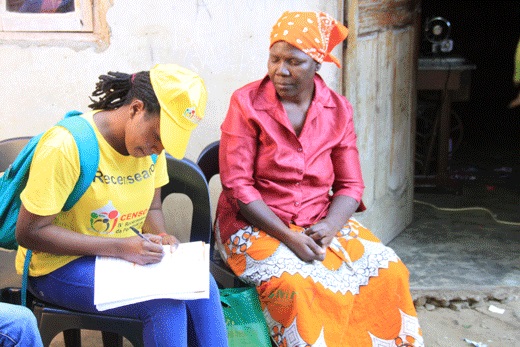Mozambique still faces extreme poverty despite technological advances
Census reaches 99 per cent of projection – INE

Notícias
By Monday, the penultimate day of Mozambique’s fourth population census, almost 99 per cent of the projected population had been counted by the census brigades, according to Cirilo Tembe, the spokesperson for the National Statistics Institute (INE).
Speaking at a Maputo press conference on Wednesday, Tembe said that by Monday the census had covered 26,822,464 people. This is 98.9 per cent of the projected population of 27,128,530. That projection results from the INE’s application of the population growth rate to the results of the previous census, held in 2007.
Tembe expected the data from Tuesday, the last official day of the census, to arrive at INE headquarters in Maputo very soon. He warned that the data for the last three days is incomplete, given the logistical difficulties faced by census brigades in remote rural areas.
The data available so far shows significant differences between provinces. Thus in Maputo City, the area where the population is easiest to count, the brigades registered slightly less than 1.1 million people – only 86.3 per cent of the expected population of the capital of 1.27 million.
But in Maputo province almost 2.46 million people were counted, which is 32.2 per cent more than the 1.86 million projected. This indicates a continuation of the trend noted in the 2007 census of migration from Maputo city into the province (particularly to the provincial capital, Matola).
Three central provinces have what the INE regards as “critically” low coverages – Tete, with only 72.3 per cent of the projection, Zambezia, with 74.7 per cent, and Manica with 82.8 per cent. Tembe believed that this was largely due to the difficulties in receiving data from the census brigades in remote areas.
In addition to Maputo, three other provinces, all in the north, have exceeded the projections – Niassa, with 104 per cent, Cabo Delgado with 124.1 per cent and Nampula with 123.9 per cent.
Although the census is officially over, counting of what the INE describes as “residual cases” is continuing on Wednesday. This includes the staff directly involved in the census, and citizens who were not able to respond in the previous fortnight, but set up interviews with census takers for Wednesday.
It also includes the leader of the Renamo rebels, Afonso Dhlakama. Tembe said that the census did reach all the areas affected by last year’s low level Renamo insurrection, including the Renamo bases themselves. He admitted that the census brigades faced “some constraints” in certain areas affected by the conflict, notably in Moatize and Tsangano districts in Tete, and in Morrumbala in Zambezia, where “some groups of people did not understand the meaning of the census”.
Tembe said these constraints “were overcome in a combined effort between the census teams and the leaders of these groups” (i.e. the local Renamo commanders).
But the base in Gorongosa district, in Sofala province, where Dhlakama is living has not yet been reached “for reasons of security”. Tembe said that Renamo has asked the INE to wait, and a definitive reply was expected from Renamo on Wednesday. The INE Sofala provincial delegate will then go to the Gorongosa base to count Dhlakama and the armed men who accompany him.
As for the reported incidents of foreign citizens who refused to answer questions from the census brigades, Tembe said that in each incident census supervisors had approached the people who claimed to be exempt, and explained the law to them.
The law states that it is obligatory for all citizens, regardless of nationality, to cooperate with the census, as long as they have resided in Mozambique for more than six months. Anyone who refuses, or who gives untruthful answers, could be jailed. When this was explained, all those approached cooperated, Tembe said. The INE had been able to cover the camps where foreign workers are based, he added (this would include camps where Chinese construction workers, for example, are living).
Only one arrest has been reported. This was of a citizen in Maputo who, on Tuesday afternoon, not only refused to answer census questions but threatened the census brigade with a firearm. He is now in police custody.
Tembe said that on Thursday, the closure of all census brigades will be verified and their charts will be checked. On Friday, all reports, material and equipment from the census brigades must be delivered to the INE. The members of the brigades will then receive the outstanding 70 per cent of their pay (the first 30 per cent was paid at the start of the census), plus any bonuses owing.
From 16 to 30 September, the INE will undertake a coverage survey to estimate how many people were omitted from the census. Previous surveys found that about five per cent of the population was omitted from the 1997 census, and two per cent from the 2007 census. This time Tembe was optimistic that the rate of omission would fall to below two per cent.
Preliminary results from the census should be published at the end of December, Tembe said, and the definitive results should be made known in June 2018.
The census brigades included over 69,000 census takers and 24,000 controllers. But once all the ancillary staff (including guides, drivers and administrators) are counted, the number of people involved in the census rises to 196,000, Tembe added.












Leave a Reply
Be the First to Comment!
You must be logged in to post a comment.
You must be logged in to post a comment.